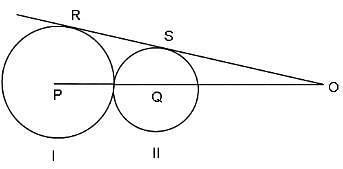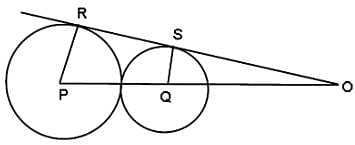CAT Exam > CAT Questions > In the adjoining figure, I and II are circles...
Start Learning for Free
In the adjoining figure, I and II are circles with centres P and Q, respectively. The two circles touch each other and have a common tangent that touches them at points R and S, respectively. This common tangent meets the line joining P and Q at O. The diameters of I and II are in the ratio 4 : 3. It is also known that the length of PQ is 28 cm.

What is the ratio of the length of PQ to that of QO?
- a)1 : 4
- b)1 : 3
- c)3 : 8
- d)3 : 4
Correct answer is option 'B'. Can you explain this answer?
| FREE This question is part of | Download PDF Attempt this Test |
Verified Answer
In the adjoining figure, I and II are circles with centres P and Q, re...
Let the diameter of circle I and II be 4x and 3x, respectively.
ΔOSQ is similar to ΔORP by AA criteria.
ΔOSQ is similar to ΔORP by AA criteria.



Most Upvoted Answer
In the adjoining figure, I and II are circles with centres P and Q, re...
Let the diameter of circle I and II be 4x and 3x, respectively.
ΔOSQ is similar to ΔORP by AA criteria.
ΔOSQ is similar to ΔORP by AA criteria.



Attention CAT Students!
To make sure you are not studying endlessly, EduRev has designed CAT study material, with Structured Courses, Videos, & Test Series. Plus get personalized analysis, doubt solving and improvement plans to achieve a great score in CAT.

|
Explore Courses for CAT exam
|

|
Similar CAT Doubts
In the adjoining figure, I and II are circles with centres P and Q, respectively. The two circles touch each other and have a common tangent that touches them at points R and S, respectively. This common tangent meets the line joining P and Q at O. The diameters of I and II are in the ratio 4 : 3. It is also known that the length of PQ is 28 cm.What is the ratio of the length of PQ to that of QO?a)1 : 4b)1 : 3c)3 : 8d)3 : 4Correct answer is option 'B'. Can you explain this answer?
Question Description
In the adjoining figure, I and II are circles with centres P and Q, respectively. The two circles touch each other and have a common tangent that touches them at points R and S, respectively. This common tangent meets the line joining P and Q at O. The diameters of I and II are in the ratio 4 : 3. It is also known that the length of PQ is 28 cm.What is the ratio of the length of PQ to that of QO?a)1 : 4b)1 : 3c)3 : 8d)3 : 4Correct answer is option 'B'. Can you explain this answer? for CAT 2024 is part of CAT preparation. The Question and answers have been prepared according to the CAT exam syllabus. Information about In the adjoining figure, I and II are circles with centres P and Q, respectively. The two circles touch each other and have a common tangent that touches them at points R and S, respectively. This common tangent meets the line joining P and Q at O. The diameters of I and II are in the ratio 4 : 3. It is also known that the length of PQ is 28 cm.What is the ratio of the length of PQ to that of QO?a)1 : 4b)1 : 3c)3 : 8d)3 : 4Correct answer is option 'B'. Can you explain this answer? covers all topics & solutions for CAT 2024 Exam. Find important definitions, questions, meanings, examples, exercises and tests below for In the adjoining figure, I and II are circles with centres P and Q, respectively. The two circles touch each other and have a common tangent that touches them at points R and S, respectively. This common tangent meets the line joining P and Q at O. The diameters of I and II are in the ratio 4 : 3. It is also known that the length of PQ is 28 cm.What is the ratio of the length of PQ to that of QO?a)1 : 4b)1 : 3c)3 : 8d)3 : 4Correct answer is option 'B'. Can you explain this answer?.
In the adjoining figure, I and II are circles with centres P and Q, respectively. The two circles touch each other and have a common tangent that touches them at points R and S, respectively. This common tangent meets the line joining P and Q at O. The diameters of I and II are in the ratio 4 : 3. It is also known that the length of PQ is 28 cm.What is the ratio of the length of PQ to that of QO?a)1 : 4b)1 : 3c)3 : 8d)3 : 4Correct answer is option 'B'. Can you explain this answer? for CAT 2024 is part of CAT preparation. The Question and answers have been prepared according to the CAT exam syllabus. Information about In the adjoining figure, I and II are circles with centres P and Q, respectively. The two circles touch each other and have a common tangent that touches them at points R and S, respectively. This common tangent meets the line joining P and Q at O. The diameters of I and II are in the ratio 4 : 3. It is also known that the length of PQ is 28 cm.What is the ratio of the length of PQ to that of QO?a)1 : 4b)1 : 3c)3 : 8d)3 : 4Correct answer is option 'B'. Can you explain this answer? covers all topics & solutions for CAT 2024 Exam. Find important definitions, questions, meanings, examples, exercises and tests below for In the adjoining figure, I and II are circles with centres P and Q, respectively. The two circles touch each other and have a common tangent that touches them at points R and S, respectively. This common tangent meets the line joining P and Q at O. The diameters of I and II are in the ratio 4 : 3. It is also known that the length of PQ is 28 cm.What is the ratio of the length of PQ to that of QO?a)1 : 4b)1 : 3c)3 : 8d)3 : 4Correct answer is option 'B'. Can you explain this answer?.
Solutions for In the adjoining figure, I and II are circles with centres P and Q, respectively. The two circles touch each other and have a common tangent that touches them at points R and S, respectively. This common tangent meets the line joining P and Q at O. The diameters of I and II are in the ratio 4 : 3. It is also known that the length of PQ is 28 cm.What is the ratio of the length of PQ to that of QO?a)1 : 4b)1 : 3c)3 : 8d)3 : 4Correct answer is option 'B'. Can you explain this answer? in English & in Hindi are available as part of our courses for CAT.
Download more important topics, notes, lectures and mock test series for CAT Exam by signing up for free.
Here you can find the meaning of In the adjoining figure, I and II are circles with centres P and Q, respectively. The two circles touch each other and have a common tangent that touches them at points R and S, respectively. This common tangent meets the line joining P and Q at O. The diameters of I and II are in the ratio 4 : 3. It is also known that the length of PQ is 28 cm.What is the ratio of the length of PQ to that of QO?a)1 : 4b)1 : 3c)3 : 8d)3 : 4Correct answer is option 'B'. Can you explain this answer? defined & explained in the simplest way possible. Besides giving the explanation of
In the adjoining figure, I and II are circles with centres P and Q, respectively. The two circles touch each other and have a common tangent that touches them at points R and S, respectively. This common tangent meets the line joining P and Q at O. The diameters of I and II are in the ratio 4 : 3. It is also known that the length of PQ is 28 cm.What is the ratio of the length of PQ to that of QO?a)1 : 4b)1 : 3c)3 : 8d)3 : 4Correct answer is option 'B'. Can you explain this answer?, a detailed solution for In the adjoining figure, I and II are circles with centres P and Q, respectively. The two circles touch each other and have a common tangent that touches them at points R and S, respectively. This common tangent meets the line joining P and Q at O. The diameters of I and II are in the ratio 4 : 3. It is also known that the length of PQ is 28 cm.What is the ratio of the length of PQ to that of QO?a)1 : 4b)1 : 3c)3 : 8d)3 : 4Correct answer is option 'B'. Can you explain this answer? has been provided alongside types of In the adjoining figure, I and II are circles with centres P and Q, respectively. The two circles touch each other and have a common tangent that touches them at points R and S, respectively. This common tangent meets the line joining P and Q at O. The diameters of I and II are in the ratio 4 : 3. It is also known that the length of PQ is 28 cm.What is the ratio of the length of PQ to that of QO?a)1 : 4b)1 : 3c)3 : 8d)3 : 4Correct answer is option 'B'. Can you explain this answer? theory, EduRev gives you an
ample number of questions to practice In the adjoining figure, I and II are circles with centres P and Q, respectively. The two circles touch each other and have a common tangent that touches them at points R and S, respectively. This common tangent meets the line joining P and Q at O. The diameters of I and II are in the ratio 4 : 3. It is also known that the length of PQ is 28 cm.What is the ratio of the length of PQ to that of QO?a)1 : 4b)1 : 3c)3 : 8d)3 : 4Correct answer is option 'B'. Can you explain this answer? tests, examples and also practice CAT tests.

|
Explore Courses for CAT exam
|

|
Suggested Free Tests
Signup for Free!
Signup to see your scores go up within 7 days! Learn & Practice with 1000+ FREE Notes, Videos & Tests.
























